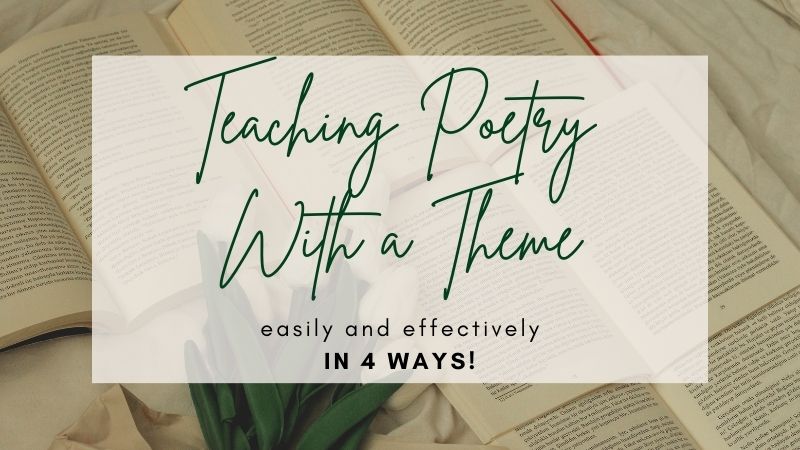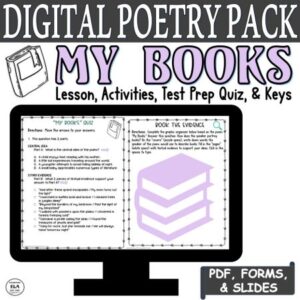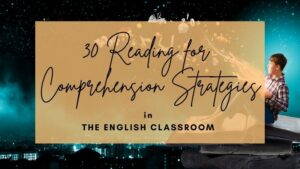The word “poetry” for many middle and high school students causes immediate fear, panic, and/or apathy. The language, syntax, form, style, topic, etc. can be quite difficult to consume. Plus, reading poetry with a theme in mind instead of merely attempting to comprehend what is going on can make teaching poetry a more complicated and/or arduous process.
Very few people read poetry for fun nowadays, but we do listen to poetry, a.k.a. songs, on a daily basis. If we, just like our students, try to read lyrics without the melody, we also might become overwhelmed. One great element of poetry, however, is that just like songs, poems always have a message.
Really, you can teach ANYTHING when it comes to poetry, BUT connecting poetry with a theme should be the end goal.
In order to truly appreciate a poem, we need to understand that the author had a purpose in writing. Keep reading below to get ideas for teaching poetry with a theme!
Need help with Test Prep? Check out this FREE Pack of 3 Test Prep Activities to help students achieve success on standardized tests!

What is a Theme?
In its most simple form, theme is simply the message the author desires to convey. Keep in mind that this message should go beyond one or two words. We don’t want a phrase. We want to see an entire sentence when teaching poetry with a theme!
Check out this poem by Kristin Menke called “My Books” and then read the poem below for theme ideas!
“My Books”
I see the pages peeking out
Like new friends soon to be old
The gilded covers call out my name
With tales from long ago
I wish I could greet each one
Either by name or by my heart
But I am resigned to realize
With only one story I can start
Since infancy my mother read
Of adventures in strange lands
Beyond the borders of my bedroom
Past the light of my lampstand
I became a pirate sailing the seas
I found the treasures of jewels and gold
I walked with pioneers upon the plains
I shivered in forests freezing cold
I marched in battles bold and brave
I climbed trees in jungles deep
I navigated rivers roaring
I scaled mountains giant and steep
And after these grand escapades
My mom turns out the light
I beg for more, but she reminds me
We will always have tomorrow night
Which theme is true based on the poem?
- Literature exposes people to different circumstances.
- Everyone deserves to have a caring mother at home.
- Traveling overseas is a thrilling part of life.
- Reading leads to becoming a great person.
The first answer is clearly the correct theme even though all of the possible answers use complete sentences and have a message. You have to ask yourself the question:
Which theme fits the poem best?
Well, the one about various circumstances can be supported by looking at different lines throughout the poem. Reading all of the options definitely helps when teaching poetry with a theme!
Click below for a detailed lesson, test prep quiz, and activity ideas for teaching “My Books” by Kristin Menke!
Teaching Poetry With A Theme
1. Focus on how poetic form contributes to the theme
There are so many formats poems can come in and each format has a purpose when analyzing poetry with a theme:
- Free Verse
- Sonnet
- Limerick
- Rhyming
- Blank Verse
- Epic
- Haiku
- Rhymed
William Shakespeare is known for his sonnets, and those sonnets are typically connected to some sort of love-related message.
Let’s look at Sonnet 18 as an example of poetry with a theme.
Shall I compare thee to a summer’s day?
Thou art more lovely and more temperate.
Rough winds do shake the darling buds of May,
And summer’s lease hath all too short a date.
Sometime too hot the eye of heaven shines,
And often is his gold complexion dimmed;
And every fair from fair sometime declines,
By chance, or nature’s changing course, untrimmed;
But thy eternal summer shall not fade,
Nor lose possession of that fair thou ow’st,
Nor shall death brag thou wand’rest in his shade,
When in eternal lines to Time thou grow’st.
So long as men can breathe, or eyes can see,
So long lives this, and this gives life to thee.
These simple 14 lines help to convey almost a love note of sorts to the speaker’s beloved. The first line typically relays the topic of the poem and the couplet in the last 2 lines reinforces the speaker’s message concerning his commitment to the one he loves.
There could be many stems to start out a fitting theme:
- True love means…
- Someone who really loves another person will…
- When a person loves someone…
- Qualities of love include…
Providing a starting point for students can really be helpful when examining poetry with a theme! (Check out this Themes Made Easy Activity to make teaching theme simple and easy!)
ACTIVITY IDEAS:
- Define each type of poetic form.
- Show examples of each poetic form.
- Ask students to locate examples of various poetic forms.
- Let students choose 1 poem with a specific poetic form and present it to the class.
- Create a gallery walk for each type of poetic form.
- Write out the theme for each poem from a different poetic form.

2. Analyze how poetic devices contribute to the theme
There are so many poetic, or literary, devices you could focus on while you teach poetry with a theme.
By high school, students should have been exposed to the following devices, but don’t be surprised if they forget these terms:
- metaphor
- simile
- rhyme
- personification
- hyperbole
- allusion (religious/Biblical, mythical, historical, literary, etc.)
- oxymoron
- understatement
- imagery
- alliteration
- assonance
- consonance
One of my favorite poems to teach poetry with a theme is “A Poison Tree” by William Blake, and the devices are plenty!
A Poison Tree by William Blake
I was angry with my friend;
I told my wrath, my wrath did end. (personification)
I was angry with my foe:
I told it not, my wrath did grow. (personification)
And I waterd it in fears, (extended metaphor: wrath as a tree)
Night & morning with my tears:
And I sunned it with smiles, (alliteration)
And with soft deceitful wiles.
And it grew both day and night. (personification)
Till it bore an apple bright. (allusion: biblical/religious)
And my foe beheld it shine,
And he knew that it was mine.
And into my garden stole,
When the night had veild the pole;
In the morning glad I see;
My foe outstretched beneath the tree.
Question: How do the poetic devices contribute to the theme?
Example Theme: Anger that is not dealt with will escalate into harmful actions.
ACTIVITY IDEAS:
- Define each type of poetic device.
- Show examples of each poetic device.
- Ask students to locate examples of various poetic devices within 1 or more poems.
- Let students choose 1 poem with various devices and present the poem/devices to the class.
- Create a gallery walk for each type of poetic device.
- Write out the theme for each poem with a focus on the importance of poetic devices.
Need more help with teaching poetry with a theme? Check out the post below!
3. Examine how diction contributes to the theme
Diction is merely word choice, but word choice is significant when it comes to determining the theme!
Take a look at the first stanza from Edgar Allan Poe’s “The Raven!”

- “Once upon” starts off the poem, almost like telling a fairy tale.
- “Weak” and “weary” describe the narrator, letting the audience know his mental and physical states.
- “Nodded, nearly napping” highlights his exhaustion.
- “Rapping” signifies a disruption of someone interrupting his quiet surroundings.
- “Nothing” demonstrates the narrator’s decision to ignore the person making the sound.
Really, we want our students to choose words that are important in some way. Sometimes, these words are highlighted, italicized, capitalized, underlined, repeated, comparative, or contrastive.
Then, they need to SAY SOMETHING about the word choice. These questions will help in thinking about poetry with a theme.
- Why did the author include this specific word?
- What tone does the word evoke?
- What message is the author trying to relay through this word?
- Is the word positive, negative, or neutral?
- What does the word mean in context?
There are no perfect answers when identifying poetry with a theme, but there are more right answers. Students must use textual evidence around the words to support their responses; without evidence, their assertions mean little.
We don’t want students guessing; we want them to infer based on other parts of the poem, especially when teaching poetry with a theme.
ACTIVITY IDEAS:
- Focus on the title and examine each word.
- Have students visualize individual words before reading the poem.
- Identify repetitive diction and explain the meaning of each.
- Present the top 5 words in the poem.
- Summarize the poem in 1 word.
- Develop a theme based on 3 words from the poem.
Check out this lesson bundle for Edgar Allan Poe’s “The Raven” to make teaching this classic poem a piece of cake!
4. Identify how syntax contributes to the theme
Syntax is an extremely difficult concept to teach, even if your students are in the upper grades and/or have high reading levels.
Syntax, the order/arrangement of words in a sentence, plays a key role in pretty much every poem. Writers, especially poets, are super conscious of how they craft a poem. I know I think about where to place words or phrases for a specific effect, and other authors do as well.
Consider Walt Whitman’s “I Hear America Singing.”
- Types of sentences: Questions, Statements, Exclamations, Commands
- Parallelism: similar sentence structures over the course of a text
- Odd Arrangements: consider any sentences or phrases that are interestingly ordered
- Poem Structure: look at how sentences are arranged from beginning to end; are there similarities and/or differences?
- Sentence Formation: identify the start, middle, and end of individual sentences
- Link Syntax of poetry with a theme: make sure to develop any examples of syntax with an identifiable theme or message
Want 30 Reading Comprehension Strategies you can use while teaching poetry with a theme? Click HERE to read about this vital topic for Reading and English teachers!
My Favorite Poetry With A Theme:
- “Because I could not stop for death”
- “Paul Revere’s Ride”
- “Fire and Ice”
- “One Song America Before I Go”
- “Death Be Not Proud”
- “The Passerby”
- “I Wandered Lonely as a Cloud”
- “Song of Myself”
- “Annabel Lee”
- “The Bells”
Need more ideas for teaching poetry with a theme? Check out my store Kristin Menke-Integrated ELA Test Prep!





